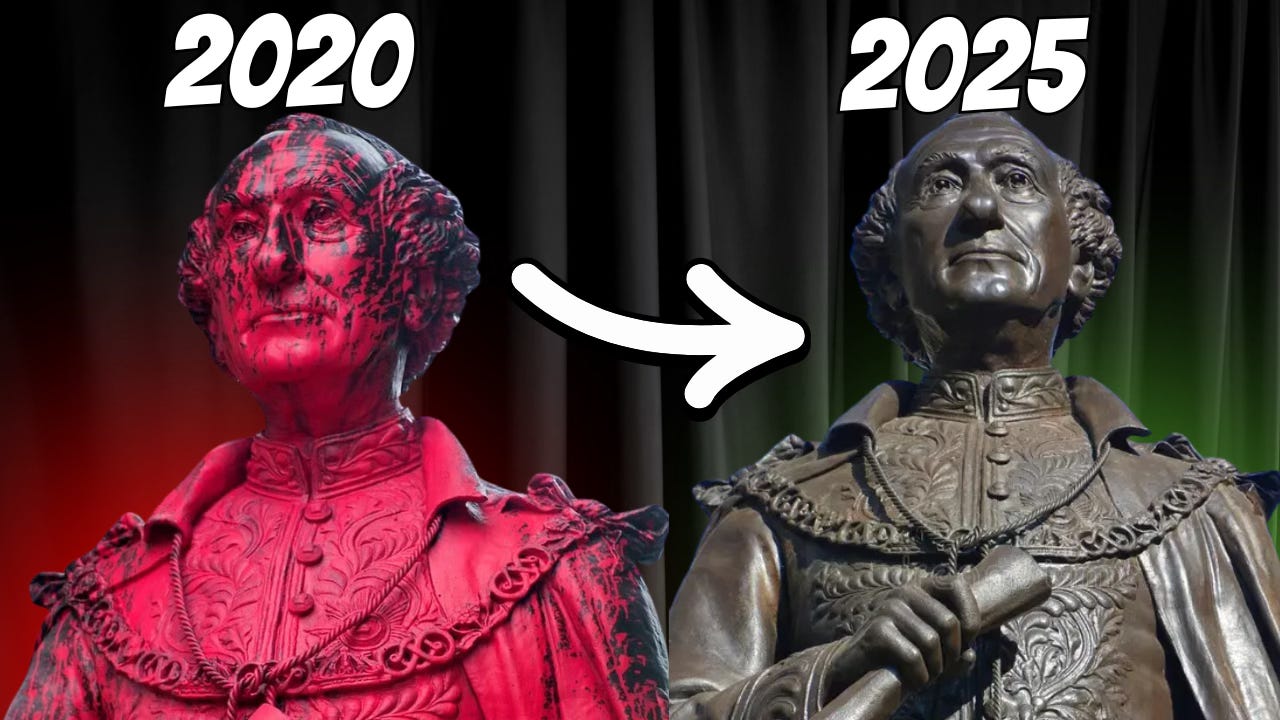What Do Statues Represent?
Friends,
You remember July, 20200 right? The height of the global pandemic, the protests on George Floyd….and the reckoning with Canada’s colonial history. Statues that, to some, glorified this chapter of our country’s past, were the target by many - particularly those associated with residential schools or other harmful legacies. Among the most prominent was the statue of Sir John A. Macdonald at Queen’s Park in Toronto. It was vandalized - and in response, the Province boarded the statue up.
Five years later, the boards have come down. The statue has quietly returned to public view, cleaned and restored — not accompanied by fanfare, but not erased either.
This moment invites an uncomfortable question: what are statues really for?
Statues are not saints (unless it’s an actual saint!)
They never were. And yet, in a moment of cultural frustration, we seemed to treat them as if they were — moral testaments to values we no longer accept. But is that what they were ever meant to be?
In an ideal world, perhaps we wouldn’t erect statues to anyone. Or at least, not without full context. History is messy. Human beings are complicated. Even those we revere — Indigenous leaders, civil rights activists, women’s rights pioneers — carried contradictions. Martin Luther King Jr., a name nearly synonymous with justice, was described by Jackie Kennedy as a man she couldn’t trust - with heavy drinking and objectifying women. Does that diminish his moral authority? Perhaps not. But it does raise a point: we don’t erect statues to people because they were flawless. We erect them because they were formative. They embodied and pushed a new form of understanding.
Sir John A. Macdonald was Canada’s first Prime Minister. Whether we like it or not, the institutions that define modern Canada — from the Constitution to the transcontinental railway — were shaped under his leadership. His involvement in the residential school system is a grave stain, but can we erase him from public memory because of it?
Canada - we’re a bit of an oddity.
See, we’re one of the only countries - perhaps the only one - actively seeking to undo historic harms. The renaming of Ryerson University to Toronto Metropolitan University is the best example. Egerton Ryerson, linked to the early frameworks of residential schools, became too controversial a namesake for a modern public institution. But did Ryerson University ever embody Egerton Ryerson’s values? Or was it simply a name — a historical reference point? I mean, it’s not like the students are learning about Egerton Ryerson - the man - during their unversity courses and being presented a glowing review of his good deeds alone. Right?
These changes aren’t just about statues and names. They reflect a deeper national tension between symbolic action and historical reckoning. At the time, few policymakers or institutions offered resistance. In fact, one might ask: why was there so little sober second thought in 2020?
Some of the fury may have been misdirected. That first pandemic summer was marked by collective disillusionment — no vaccines, continued lockdowns, a social fabric stretched to its limits. When societal frustration is high, symbols become lightning rods. Statues became scapegoats.
But five years on, we seem to be walking some of it back.
The reinstatement of the MacDonald statue, like a quiet whisper, suggests an evolving recognition: our history is not the same as our morality. Statues, in this light, are not endorsements — they’re acknowledgements. A nation must have founding figures, however flawed. Without Macdonald, there is no confederation, no Dominion of Canada, no constitutional foundation.
We might say: “Well, then let’s also raise statues to Indigenous leaders, to Black Canadians, to women who shaped our nation.” Yes — absolutely. But as those stories are researched and commemorated, we should be careful not to hold them to a higher moral standard than we hold the rest of history. Because if moral perfection becomes the threshold for remembrance, we risk remembering no one.
Regardless what you think, statues are there to make you think. And perhaps that is the lasting legacy of Sir John A. MacDonald’s statue,


